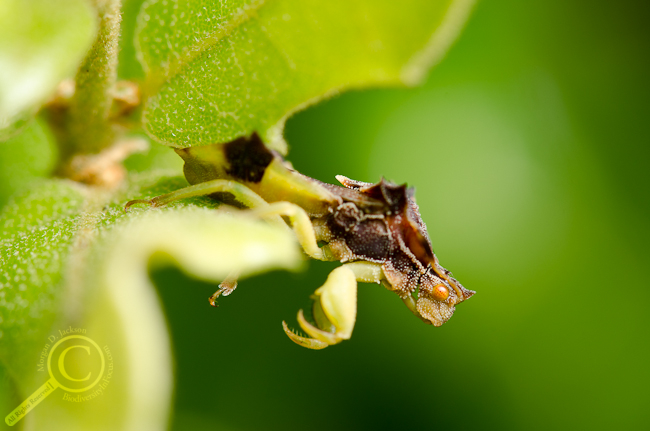While I’ve been using my camera in Manual mode and manually focusing my photos for years, I’ve stuck to using TTL flash, with fairly inconsistent results. One of the points Alex made during his BugShot lighting session was to try using manual flash to gain consistent control over the light output. I decided that would be one of the areas of my photography I’d concentrate on improving next, taming light to act how and where I wanted it to, and this was one of the shots that made me start thinking I was getting a hang of it.
Because there was such diversity of light and dark areas, from the shadowy region between leaves to the light regions on the ambush bug’s arms, being in manual flash mode meant I didn’t have to worry which area my flash was going to expose for, and as a result, I got consistent lighting as I adjusted compositions and focus planes between shots. Luckily this ambush bug was patient and posed nicely while I got things figured out!
Also, apparently ambush bugs aren’t their own family anymore, but rather a subfamily (Phymatinae) of the assassin bugs (Reduviidae)! Who knew? Damn phylogeneticists not thinking to send me a memo when they shake things up like that…


Manual versus TTL flash is one of those areas where photographers begin to disagree depending on style, technique, subject, etc. Manual is very good for consistent results in a controlled situation, and of course it is unparalleled as a tool for learning the relationship between flash power level and results. However, most of my shooting is done in more dynamic situations – changing distance between subject and lens, changing background, changing ISO/aperture/speed for different effects. In this situation manual can be very clumsy to work with because it must be adjusted constantly. There are two problems with the – 1) manual flash power must be adjusted on the flash unit itself, not allowing one to continue looking through the viewfinder, and 2) power is adjustable only in full stops, limiting precision of control. TTL (on cameras that support it) overcomes both of these obstacles and allows me to concentrate on composition – especially with skittish subjects for which I want to minimize any movement.
Maybe this would be a good subject for a blog post…
Those are good points, Ted. My bias towards manual flash is rooted in my tendency to shoot ants at their nest entrances, where the contrast between black entrance holes and white sand causes TTL flash to roam all over the place. I suspect the choice of M or TTL will depend on the circumstance, much like the decision to manually focus (which I do for macro) or auto-focus (which I do for sports).
I wish you could have made it this year! We had a great group, again.
Yes, I can see the problem with TTL in that situation. Just goes to show that there are rarely any one-size-fits-all solutions.
Thanks for your thoughts Ted! I agree that modifying Manual flash output isn’t as straightforward as changing other controls, but I am able to adjust Manual flash power in 1/3 ev steps, both on the flash itself, and remotely through my camera-based trigger. Perhaps this is a Nikon-only feature (not to start a Nikon vs. Canon debate of course), but it is possible.
“Also, apparently ambush bugs aren’t their own family anymore … Damn phylogeneticists”
I felt the same when I first found this out, but this seems to be more a case of returning to their proper home than bloody phylogeneticists. Carayon, Usinger, and Wygodzinsky (1958) sank Phymatidae into a subfamily of Reduviidae (I haven’t seen it, but presumably this was a pre-cladistic study), but Nicholas Kormilev (1962) reversed this ‘unfortunate’ degradation. Since then the taxonomic literature was split between family and subfamily status until the 1990’s, but the ecological/ biocontrol/ behavioural literature overwhelmingly has been Phymatidae. Hence, no doubt, our ignorance.
Since Christiane Weirauch’s paper (Syst. Ent., 33 (2008), pp. 229–274) and Tony Schuh and colleagues 2009 paper (DOI: 10.1111/j.1365-3113.2008.00436.x), both with seemingly good morphological synapomorphies, there doesn’t seem any logical reason to exclude Phymatinae from the Reduviidae and this relationship has led to an interesting paper by Weirauch et al. on the evolution of raptorial legs (DOI: 10.1111/j.1096-0031.2010.00325.x).
Interesting that Phymata americana occurs in both Florida and Alberta.
As always, thanks for the lit review Dave! I’ll have to read up on why ambush bugs are really ambushing assassin bugs now, but it would seem things are pretty well settled at this point, so I best change my mental road map to insect taxonomy!